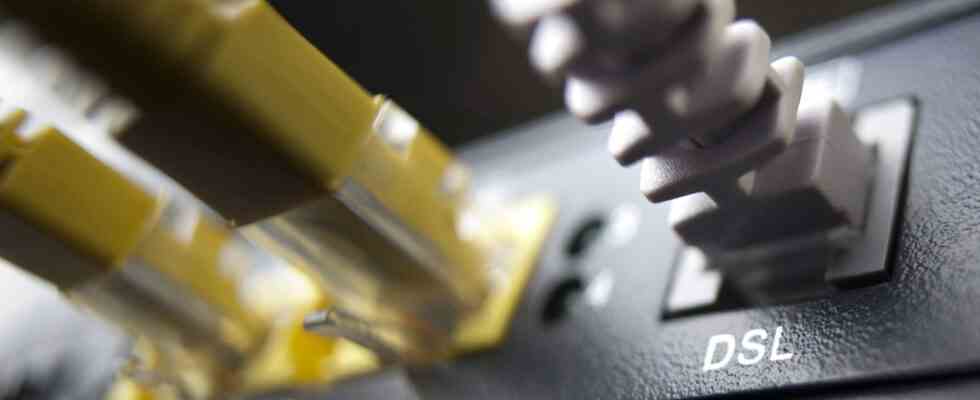Status: 13.12.2022 06:33 a.m
A year ago today, the new measurement tool was launched, with which consumers can check their fixed-line Internet and thus assert reduction claims. The balance sheet is mixed.
Measure your own Internet connection and pay less money per month if there are deviations from the conditions: That is the idea behind the widebandmessage.de measuring instrument for consumers, which the Federal Network Agency set up on December 13, 2021 as part of the amendment to the Telecommunications Act.
If the network at home is significantly worse than contractually agreed, the households are entitled to a reduction in the monthly payment. A year after the introduction of the so-called price reduction right and the associated tool, which can be used in the browser or as a desktop app, the bottom line is a mixed balance.
user numbers are falling
One thing is clear from the test measurements, which will soon also be available for mobile communications: In thousands of cases, Internet companies are still offering far too poor a service. From mid-December 2021 to the end of October 2022, consumers completed around 28,000 measurements that are necessary for the legal claim, as the Federal Network Agency announced this week in response to a dpa request. Almost exclusively a reduction claim was found.
President of the Federal Network Agency, Klaus Müller, is therefore satisfied: “The measuring tool has become well established after a year,” emphasizes the former consumer advocate. “We help thousands of consumers to prove that their provider is underperforming.” Since the beginning, the app alone has been downloaded and installed an impressive 100,000 times. Many consumers began the time-consuming measurements, especially in the early days.
The problem: numerous users did not finish it. 30 tests over three days are required, with varying intervals of time between the tests. Only those who persevere get a protocol at the end. In addition, the initial interest generally ebbed away quickly. A good half of the measurements mentioned (15,000) were already carried out in the first two and a half months after the start.
Slow Internet: Reduction per measurement protocol
Contracts for Internet tariffs contain a product information sheet in which the provider states the maximum, the minimum and the data rate normally available. According to the legal regulation, there must be no “considerable, continuous or regularly recurring deviation” from these specifications, otherwise the consumer can assert a claim for a reduction.
For the new reduction right, consumers have to use the “breitbandmessung.de” desktop app for broadband measurement from the Federal Network Agency, but via the LAN cable and not via the WLAN, because wireless access to the fixed network Internet speeds up.
In order to get a measurement log, a total of 30 measurements on three different calendar days are required. There should be at least five minutes between the measurements, or at least three hours between the fifth and sixth measurement of the day. The total period for the “measurement campaign” must not be longer than two weeks.
Criticism of lack of transparency and high effort
Consumer advocates refer to a number of negative aspects. One point of criticism: The measurement log contains no information about how much consumers can actually reduce their monthly bill. You have to clarify this individually with your provider. It is only regulated whether the speed of fixed-line broadband connections conforms to the contract or not – for example, if the normally available speed is not reached in 90 percent of the measurements.
In the finished log, the households can finally see whether there is a deviation. Internet providers use different criteria to calculate the specific amount of the reduction. For consumers, it is sometimes “not explained in a comprehensible manner, even when asked, how the reduction amount comes about,” claim the consumer advice centers. For this reason, they offer a reduction calculator on their website that allows users to know the exact amount of reduction they are entitled to.
However, the reasons for the recent decrease in the number of measurements are unclear. The consumer centers point out that the measurements are too complex and not user-friendly. According to their estimate, the number of unreported households that have poorer Internet than contractually agreed is high.
Industry sees positive development
Internet providers, on the other hand, see the development as proof that their performance has improved. In addition, the number of measurements with demonstrably deficient Internet is very small in relation to the 38 million broadband connections in Germany. “In our opinion, the overall very low number of complaints clearly shows that the vast majority of users feel that they are well looked after with their Internet connections,” says Jürgen Grützner from the Internet industry association VATM (Association of Providers of Telecommunications and Value-Added Services).
At Telekom, for example, the number of complaints is, according to its own statements, at a low level with a low three-digit number per week. “We take care of every case and are always looking for accommodating solutions in the interests of our customers. Of course, we also grant the legally required reductions,” said a spokeswoman for the Bonn-based group. So far there have been no complaints. Vodafone made a similar statement. “Only very few fixed network customers have so far applied for a reduction, which we have of course granted in justified cases,” said a company spokesman.
Consumer advocates nevertheless criticize the providers. According to their findings, the companies rejected a reduction “usually or do not react, although the necessary documents were submitted,” according to a statement by the Federal Association of Consumer Organizations (vzbv). If a company is actually stubborn, consumers can go to the district court. There they could have good cards after the law changed a year ago.

